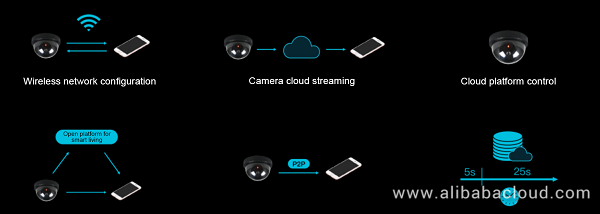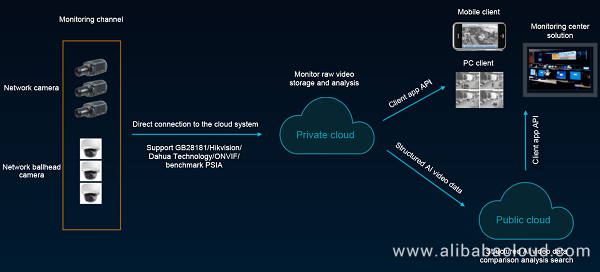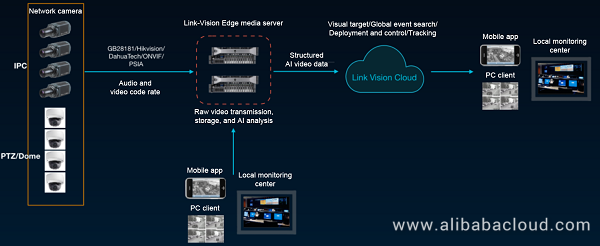By Alibaba Internet of Things Team
Shaobin from Alibaba Cloud gave a speech entitled "Link Vision Internet of Things (IoT) Smart Video Service" on the 2018 Apsara technology platform. He briefed the functions of the camera SDK released by Link Vision in the first phase, detailed the functions of the edge multimedia gateway, Link Vision Cloud, and client SDK, and shared the solutions of the Link Vision IoT smart video service.
In 2005, China's video surveillance market was worth 3 billion RMB. By 2016, the market value reached 86.7 billion RMB, with an average annual growth rate of 30%. In the entire video surveillance industry, enterprise users account for more than half. In such a market, Alibaba Cloud divided the smart video service into two product lines, one of which is to open the IoT smart video service open platform for small enterprise users and home users, and the other is to launch E2E IoT smart video solutions in the enterprise-level market.
Video surveillance products are presented to customers in two modes: point-to-point (P2P) and cloud. The problem with the P2P mode is that, when the geographical span is large, the network symmetry is poor, and P2P video transmission suffers from many congestion points in the entire network, which causes many intermediary routers to lose data packets and therefore results in poor transmission stability of network videos.
In P2P mode, videos are stored locally. In case of security events, terminal cameras can be easily damaged, resulting in the loss of recordings. In addition, there are several drawbacks with this mode, including images are stuck and unclear during real-time playback, mobile phones cannot be used to control cameras remotely, and once a security event occurs, users cannot be alerted in real time.
The cloud center model has two major advantages. First, it supports network interconnection across operators, which enables smooth and clear real-time video transmission, secure video storage, and reliable security event reporting. Second, it supports inter-cloud cascading across geographical areas. Users can view videos recorded by cameras even in different countries. Cameras trigger warnings over the client in case of security events.

The Link Vision IoT smart video service open platform helps significantly reduce the R&D investment in cloud platforms for consumer video surveillance camera manufacturers. When a user gets the camera, the user first needs to configure network connection for the camera. The Link Vision camera development kit provides a variety of wireless network configuration solutions, which helps camera manufacturers develop wireless network configuration functions that best fit their hardware architecture and business model. After the network configuration is successful, the camera and the mobile phone establish account interconnection on the open platform for smart living. This platform provides integrated services such as cloud package service management and camera software upgrade management. A user can view real-time video streams on the mobile client in two ways. One way is to view directly connected P2P live videos if the camera and mobile client are in the LAN, and the other way is to view forwarded live videos over the cloud if they are in the WAN. Link Vision also supports cloud platform cameras with multiple commands from multiple manufacturers by providing a dual-ended SDK and translating instructions on the cloud. In the event of security events, the alarm recording module uploads a 30s video clip to the cloud for each security event, which reduces the cloud storage cost. The cloud storage service for alarm recordings charges end users. The charging mode and cloud package service management are integrated on the Link Vision IoT smart service open platform, eliminating the necessity for manufacturers to develop the cloud business.
There are many problems with traditional video surveillance solutions. In terms of reliability, the front-end storage and back-end platform are uncertain; in terms of performance, the traditional embedded NVR system can hardly provide sufficient AI computing on the edge side for complex deep learning algorithms, and the centralized access to videos faces a large bottleneck; in terms of data security, NVR storage results in dispersed surveillance videos that are difficult to centrally control; in terms of scalability, horizontal expansion of the edge-side NVR scheme requires NVR and platform construction and configuration, which brings high labor costs; in terms of customization, the embedded NVR system has a long service customization cycle, generally 6 to 12 months; in terms of system latency, the traditional video surveillance solution has a delay of 500 ms to a few seconds in the storage and platform phases, which is unbearable for modern video services.

To address these problems, two solutions are proposed in the industry. One solution is to directly connect network cameras to the private cloud. All raw videos are directly stored in the private cloud, which is cascaded to the upper-level private cloud monitoring center. However, this solution has a big drawback. The network pipe between network cameras and the private cloud is extremely expensive, so this pure cloud solution is suitable only for large enterprises with abundant budgets.

Link Vision provides a cloud-side collaborative video solution. This solution strengthens edge computing and storage nodes instead of cancelling them, stores the raw videos of all network cameras on an edge media server, accurately structuralizes deep learning AI for raw videos by deploying the powerful AI computing capability, and uploads the AI-analyzed structured video data to Link Vision Cloud. Link Vision Cloud centrally stores the structured video data of all monitoring channels in the entire system, and implements global search, deployment and control, and tracking of visual objects and security events. The monitoring center uses professional terminal media workstations, which can directly link to the TV wall or play surveillance videos on the TV wall by decoding the videos over a professional embedded decoder.

The edge media server not only implements the video access cloud capability of connecting the front-end network cameras to the back-end Link Vision Cloud, but also forms a small closed-loop monitoring solution on the edge side. Therefore, the edge media server can also decode surveillance videos by using an embedded decoder and play the videos on the wall. When a user's external network fails, a closed-loop video surveillance system with AI analysis capability can be formed locally.
The edge media server supports mainstream manufacturers' network camera protocols such as the national standard GB28181 and international standards ONVIF and PSIA, and proprietary protocols. They can directly store massive raw videos on the edge side, perform structural AI analysis on video data by using its powerful AI computing capability, and upload the structured video AI data to Link Vision Cloud. This cloud-side collaboration mode improves the global search efficiency of visual objects and security events, and significantly reduces the network pipe cost from network cameras to Link Vision Cloud. The Link Vision cloud-edge collaborative smart video solution will be the mainstream solution for large video systems in the future.
To learn more about Alibaba Cloud IoT solution, visit www.alibabacloud.com/solutions/IoT
August Announcement of Alibaba Cloud Community Builder Program

2,599 posts | 764 followers
FollowAlibaba Clouder - November 23, 2018
Nong The Hoang - March 4, 2024
Alibaba Clouder - January 19, 2021
Alibaba Clouder - October 11, 2019
BaitaoShao - July 28, 2020
Alibaba Clouder - October 26, 2020

2,599 posts | 764 followers
Follow EDAS
EDAS
A PaaS platform for a variety of application deployment options and microservices solutions to help you monitor, diagnose, operate and maintain your applications
Learn MoreLearn More
 CEN
CEN
A global network for rapidly building a distributed business system and hybrid cloud to help users create a network with enterprise level-scalability and the communication capabilities of a cloud network
Learn MoreMore Posts by Alibaba Clouder